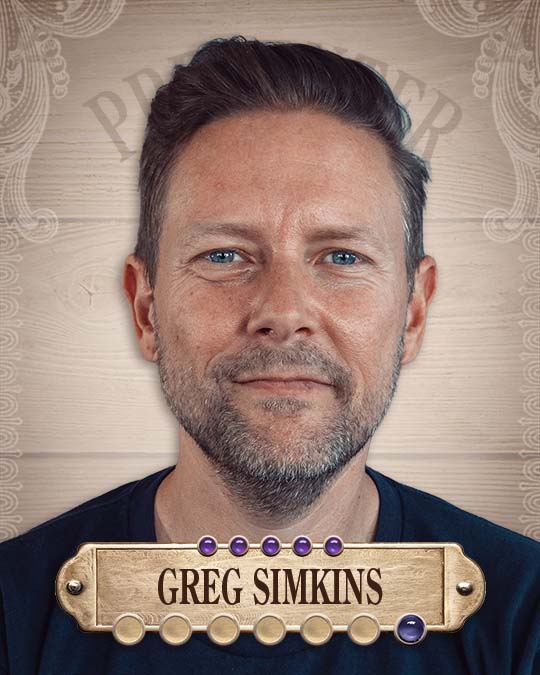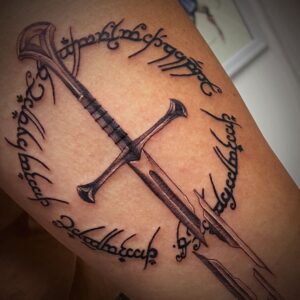An Overview of Today’s Popular Tattoo Styles
This year, we are thrilled to introduce a new feature on our website to help you sort through our attending tattoo artists. On the Tattoo Artist Page we have added a style drop-down menu, where you can select the style you are looking for, and it will show you the artists who specialize in that particular style. As tattoos continue to evolve, the variety of artistic styles and skills required to perfect them continues to grow. Below we have listed most of the major tattoo styles so you can discover the style that best fits your aesthetic and become more informed about each one
American Traditional
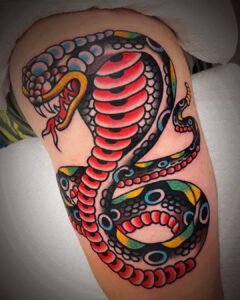
When you think of tattoos, the images that often come to mind are those with bold lines, vibrant colors, and iconic imagery. These characteristics define American Traditional tattoos, a style that has stood the test of time.
Emerging in the late 1700’s American Traditional tattoos, also known as Old School Tattoos, were largely popularized by pioneers like Norman “Sailor Jerry” Collins. Its timeless appeal has often symbolized freedom and rebellion, largely due to its history and association with sailors, soldiers, and the working class.
Given this connection, the designs are often rich in symbolism, featuring images such as skulls, roses, eagles, pin-up girls, and a variety of other motifs. These designs frequently carry deep meanings such as love, loyalty, strength, etc. Traditionally, the color palette of these tattoos is limited to red, yellow, blue and green. This is due to the pigments available when the style first emerged. Bold black outlines are a staple of this style and give traditional tattoos their signature while also ensuring they age well.
Neo-Traditional
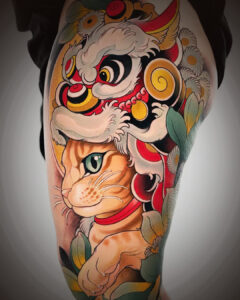
Neo-traditional tattoos offer a modern take on classic tattoo techniques. While they share similarities with traditional tattoos in terms of line work and bold colors, Neo-Traditional tattoos take things to the next level by adding more depth, detail, and perspective. This is achieved through their wide range of colors and varied line thickness.
The line work found within a Neo-traditional piece is often used to enhance clarity within the design, rather than serve as a focal point. It helps define composition, reduce color clashes, and highlight small, intricate details. These details can include fine-line textures such as fur, feathers, or softer gradients in skin tones.
The versatility of this style and its incorporation of more details, as mentioned previously, allows both the artist and client to enjoy more freedom in their designs. Allowing them to create abstract concepts or, more commonly, representations of plants, animals, and mythical creatures. In addition to this, Neo-traditional tattoos are known to take inspiration from Ukiyo-e Japanese prints, Art Nouveau, and the Art Deco movement. Reflecting a “return to nature” in their themes and aesthetic.
Color Realism

If you love tattoos that look 3D or like a photograph, you might consider color realism. This style uses a broad range of colors and saturation to create a lifelike image. Many people choose this style to immortalize memories or recreate photographs of loved ones, such as children or pets. However, artists can incorporate surreal elements to depict powerful themes and bring the imaginary to life
Creating color realism tattoos requires a deep understanding of color theory and a mastery of layering techniques to build depth and dimension. The use of color, shading, and especially highlights, is essential for achieving realistic details. The color palette, combined with these shading techniques, plays a key role in emphasizing the “vibrancy of life” or capturing the essence of the moment being depicted.
You can see these elements come into play during the tattoo process. You may notice that the stencils include contour and highlight guides to help the artist define the piece with precision. A photo reference is also kept nearby to ensure the artist stays true to the desired image.
Black and Gray Realism
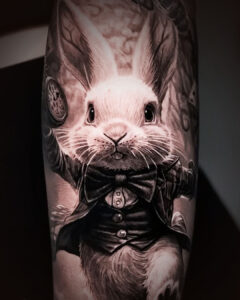
Black and Grey Realism is perhaps the most popular tattoo style these days. Similar to color realism, it uses various techniques in terms of layers and highlights but relies solely on black, grey, white and greyscale gradients to achieve depth and details. Many trace the style’s origins to the influence of Chicano culture or paintings, and as this style has evolved, new tips and tricks have emerged to bring it to where it is today.
Concerning the process of said style, photo and stencil alterations are important; however, some artists may practice with physical mediums like charcoal or graphite pencil to help capture the essence of using such a limited color palette. This style also features more persistent line work to help add delicate detail as an addition to the depth and smoothness of the design. As color realism is typically used for portrait design, so is black and grey realism. However, rather than feeling lifelike, some would consider the monochromatic style to be a way to memorialize or capture the essence of the subject. In terms of practicality, this style is versatile and pairs almost seamlessly with any other subject matter you may incorporate or perhaps other tattoo styles and whatever clothing you like to wear.
New School
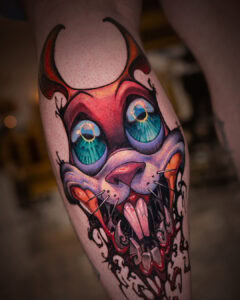
New school tattoos offer endless opportunities for creative expression and can often feature cute or humorous intent. This style draws inspiration from a variety of techniques and artistic elements, making it both distinct and versatile. A lot of early new school tattoo artists were influenced by graffiti art or studied street art for their stylistic features, bold color, and smooth lines. These are all features that can be found in new school tattoos today, alongside caricatures that often present exaggerated features like disproportionate heads and eyes. In addition to this, the style often includes pop culture references due to the explosion of technology and entertainment in the 90s.
As new movies, video games, cartoons, comics, etc., emerged, so did correlating fandoms. These phenomena became a significant source of tattoo inspiration as they allow people to show off their interests and can serve as a sense of childhood nostalgia. A great example of this style would be Disney character tattoos, where their designs have been altered to be more playful yet still recognizable. For example, the Cheshire Cat is a common New School style tattoo, along with other animal sidekicks.
Japanese
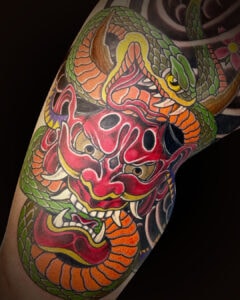
Japanese-style tattoos, or Irezumi, have strong roots in history and heritage. The cultural rules and regulations, such as placement and motif choices, help to set this style apart. Unlike smaller designs, Japanese-style tattoos are often in large, standalone pieces that cover areas like the back, legs, or arms, leaving room for traditional garments like kimonos.
Ukiyo-e, a genre of woodblock prints, has heavily influenced the tattoo industry. Known for its vibrant colors and flattened perspective, this era’s imagery continues to inspire modern tattoo designs. The most classic Ukiyo-e motifs that are still relevant today include tigers, koi fish, samurai, waves and dragons. People are often drawn to the bold color within these clean designs and the flow of compositions, alongside the skill involved in creating them by hand-poking, which is also known as tebori. While hand-poking is not as common nowadays, it is where the signature soft look of Japanese-style tattoos originated.
Many have questions about the cultural significance of this style, given its strong symbolism and traditional roots. However, the style doesn’t discriminate and has proven to be inclusive to its audience, provided you respect the rules. Rule one emphasizes the importance of a large piece, whereas rule two highlights the incorporation of symbols and themes drawn from Japanese culture (do not get this confused with the art styles and themes of manga). Rule three reinforces the importance of adhering to the first two rules.
Black Work
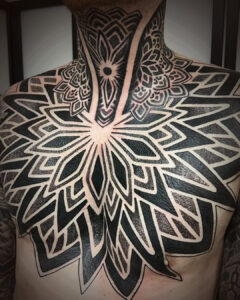
Blackwork tattoos are, as the name suggests, completely black- there is no use of gray or color, which makes this style distinctly bold. Despite its simplicity, blackwork encompasses a range of substyles, such as geometric shapes, abstract designs, dark art, and more.
This approach is deeply rooted in both tradition and heritage, often reflecting tribal stories, cultural symbols, and spiritual meanings. The tattoos feature striking bold linework, intricate variations in line thickness, and large filled-in sections of black ink. Additionally, the use of stippling, or “skin breaks,” is common, where areas of uninked skin are incorporated to create shading effects or visual illusions. These skin breaks not only highlight specific elements of the design but also serve to add contrast and depth, making the tattoo feel more dynamic.
While blackwork tattoos are a popular choice in themselves, they are also famous for cover-up opportunities or reworking older tattoos due to their large capacity to mask or transform previous artwork into something fresh. This style can range from geometric shapes and patterns to organic shapes and textures to illustrative imagery. The number one thing that sets it apart is the strict use of just black ink.
Fine Line
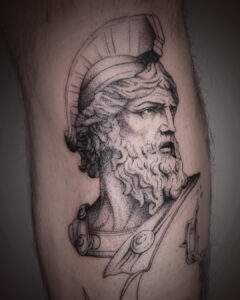
As the name suggests, fine line tattoos are defined by the use of thin lines to create intricate, detailed designs. This approach emphasizes minimalism, with light lines, subtle shading, and often little to no color.
Due to the nature of these tattoos, great attention to detail is required from both the artist and the client, as even the slightest mistake can be noticeable. Precision is key, and it can take a lot of practice to master the skills necessary, such as the perfect straight line or executing a flawless circle. This is especially true for the most popular design in this style, which includes geometric patterns, flowers, celestial symbols, and short quotes.
The placement of fine line tattoos is highly versatile. You’ll often find them on the wrist, ankle, or behind the ear, as they tend to represent personal symbols tied to specific moments or people in someone’s life. Like most tattoos, shading can be an important factor, but it’s typically light and can be enhanced with stippling for a more artistic or stylistic approach. If subtle expression is your go-to, fine line tattoos may be the perfect choice for you.
Lettering
Lettering tattoo artists are often highly skilled in linework and customization, with a deep understanding of how to craft text in a way that complements the wearer’s personal style. The typography or font choice is the most critical element in this tattoo style as it defines the overall aesthetic. Fonts can range from decorative and ornate to traditional block letters, each conveying a different tone or emotion.
This tattoo style is frequently used for names, dates, scriptures, or song lyrics and is often deeply personal, representing a strong emotional connection to the wearer’s life, beliefs, or memories. Artists who specialize in lettering develop their own unique approaches to shading and design, giving each tattoo a distinct flair. Shading, in particular, can vary significantly between designs and individual artists, ranging from soft gradients to bold and dramatic contrasts.
Incorporating banners or borders is a common design element, often seen in historic or fantasy-style books, where the words are framed in a way that adds elegance. The length of the words or phrases can influence placement, longer phrases are often featured in big areas such as the ribs or chest, while single words are typically placed on the forearm, wrist, or even behind the ear. However, the small, more confined spaces (such as behind the ear) can limit the ability to add extensive design elements or intricate details.
Jack of All Trades
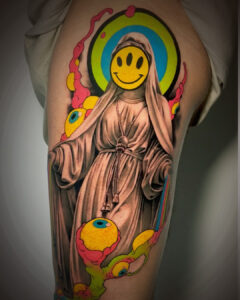
If you’re not looking for an artist who specializes in just one style, or perhaps you want someone who specializes in a little bit of everything, this is the approach for you. Sometimes, choosing between different tattoo styles can feel overwhelming, especially when you’re unsure about which one will best suit the design. Opting for an artist with a broad skill set offers you more versatility, not only in the design process but in the ability to blend different elements. This flexibility can open the door to creative combinations that could later influence other artists or other tattoos you hope for in the future.
These are just a handful of the most popular styles we wanted to highlight; the list of tattoo styles is extensive and ever-expanding as more and more artists innovate and push the boundaries of the industry. We take great pride in the 37 years of tattoo history encapsulated in this convention. The show has always been a place for incredible artists to come together and celebrate the art and craft of tattooing. One of our goals is to make sure we bring some of the best artists from every style, as well as the OGs who created and shaped them. Head over to our Tattoo Artist page to see this year’s talent and check out the new style menu option to find your next tattoo artist!
More...
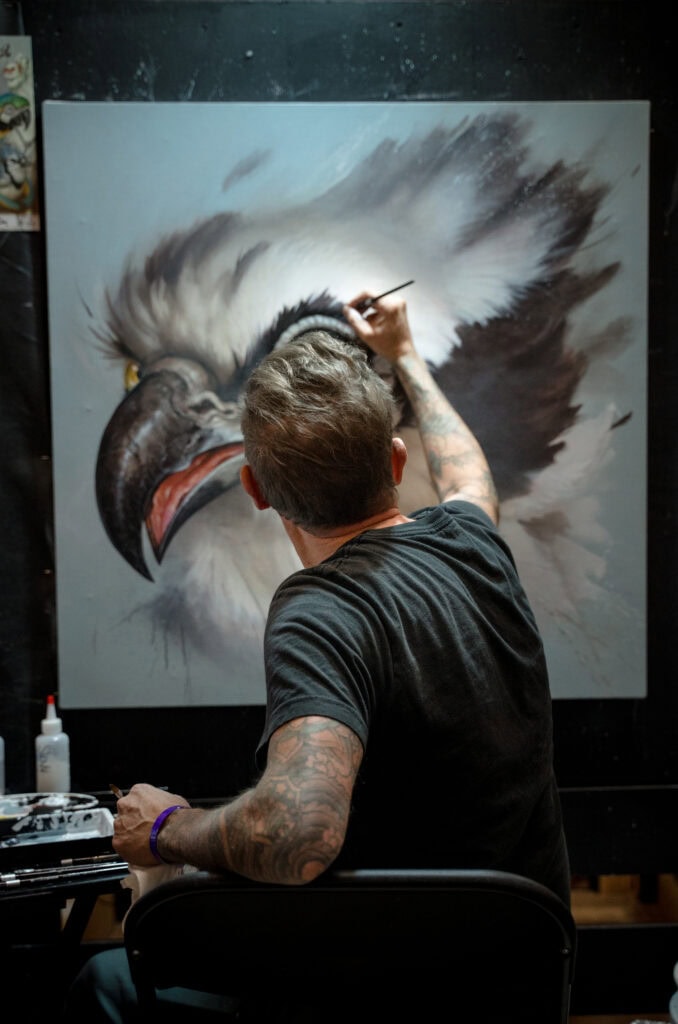
Thank You For Helping Us Donate $5,000 to Studio Two Three
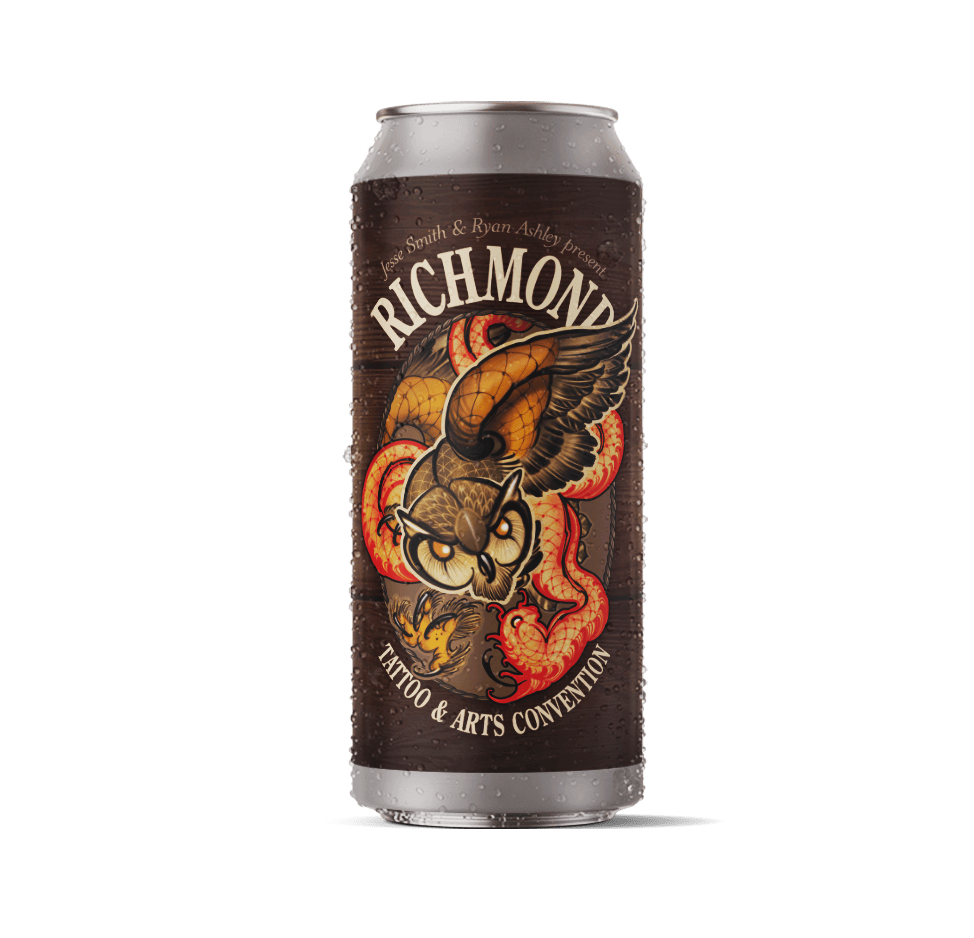
Richmond Tattoo & Arts Convention + Bingo Beer Co. Unveil Limited-Edition Convention Beer Design

Richmond Tattoo & Arts Convention: A Global Celebration with Family at Its Heart
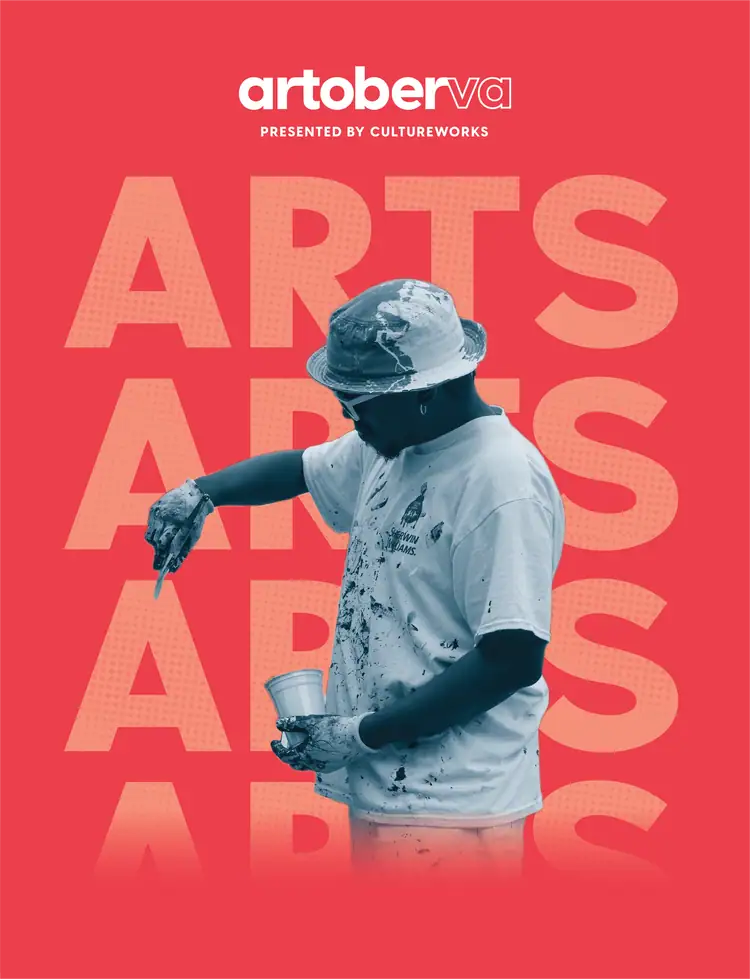
Five top art Experiences in Richmond, VA: October is artoberVA!
